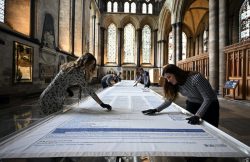 THE summer exhibition at Salisbury Cathedral, on until 17th September, is To Be Free. It brings together some of the world’s leading contemporary artists, exploring what freedom is, what it means to be free, how it feels to be free and the plight of those who are not free.
THE summer exhibition at Salisbury Cathedral, on until 17th September, is To Be Free. It brings together some of the world’s leading contemporary artists, exploring what freedom is, what it means to be free, how it feels to be free and the plight of those who are not free.
With conflicts in Sudan, the Middle East and the Ukraine dominating the news and the unsettling debate around immigration flaring intermittently, To Be Free feels exceptionally timely and important.
The Cathedral’s visual arts curator, Beth Hughes, has created a memorable and provocative selection, featuring artists including Ai Weiwei, Yinka Shonibare, Mona Hatoum and Cornelia Parker. In some cases, the artists themselves have seen freedom challenged at first hand.
A centrepiece of the exhibition is Cornelia Parker’s Magna Carta (An Embroidery), a 13-metre-long embroidery installation depicting the Magna Carta Wikipedia pages. This huge piece is the perfect complement to Salisbury Cathedral’s rare 1215 Magna Carta, which is on display in a newly updated exhibition in the Chapter House.
Magna Carta (An Embroidery) was an act of democracy in its making, with more than 200 hand-stitched portions sewn by civil rights campaigners, MPs, lawyers, barons, artists and 36 prison inmates from 13 different prisons in England. The prisoners worked under the supervision of the social enterprise group Fine Cell Work.
 Another astonishing work is Yinka Shonibare’s Justice For All, which was first exhibited in the UK during the summer of 2020 in response to the tragic killing of George Floyd. The towering figure is a reimagining of FW Pomeroy’s Lady Justice, which stands above the dome of The Old Bailey. Shonibare has replaced Lady Justice’s head with a globe, asking us to consider justice for citizens across the world. The scales of justice hang from her left hand and a swift sword of authority is in her right hand.
Another astonishing work is Yinka Shonibare’s Justice For All, which was first exhibited in the UK during the summer of 2020 in response to the tragic killing of George Floyd. The towering figure is a reimagining of FW Pomeroy’s Lady Justice, which stands above the dome of The Old Bailey. Shonibare has replaced Lady Justice’s head with a globe, asking us to consider justice for citizens across the world. The scales of justice hang from her left hand and a swift sword of authority is in her right hand.
Standing at the west end to greet visitors as they arrive, Justice for All faces Gabriel Loire’s famous Prisoners of Conscience window at the east end, which is dedicated to those who suffer or have been imprisoned because of their personal, religious or political beliefs.
 A smaller but equally compelling work is Ai Weiwei’s porcelain Free Speech Puzzle 2015. The interlocking ceramic pieces, laid out to resemble a map of China, are each decorated with two hand-painted Chinese characters which translate to ‘free speech’. Each piece represents a distinct geographic and ethnic region of China, and the artist is asserting that everyone, wherever they are, has the right to free speech.
A smaller but equally compelling work is Ai Weiwei’s porcelain Free Speech Puzzle 2015. The interlocking ceramic pieces, laid out to resemble a map of China, are each decorated with two hand-painted Chinese characters which translate to ‘free speech’. Each piece represents a distinct geographic and ethnic region of China, and the artist is asserting that everyone, wherever they are, has the right to free speech.
Other artists include Mona Hatoum, showing her 2019 work Map (mobile), challenging ideas of ownership and freedom, Lucy Jones, who explores the challenges of gender, age and disability and Jeffrey Gibson, whose textile work They Want to be Free 2021 reflects his Choctaw-Cherokee heritage.
The exhibition continues to 17th September.
Pictured: Ai Weiwei’s Free Speech Puzzle, Yinka Shonibare’s Justice For All, and Cornelia Parker’s Magna Carta (An Embroidery), Photographs by Finnbarr Webster.